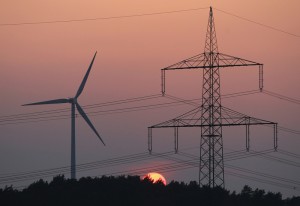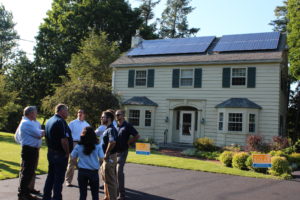 Here’s my hypothesis[1]: The abundance of cheap domestic natural gas – what I’m calling the Natural Gas Revolution – makes “renewable” energy sources like wind and solar financially untenable, and possibly unnecessary, for the next 90 years.[2]
Here’s my hypothesis[1]: The abundance of cheap domestic natural gas – what I’m calling the Natural Gas Revolution – makes “renewable” energy sources like wind and solar financially untenable, and possibly unnecessary, for the next 90 years.[2]
I can’t prove my hypothesis because energy pricing is complicated.
Figuring out the ‘price’ of energy derived from traditional fuels such as coal, natural gas, and nuclear is not as straightforward as it may seem. I’ve made an attempt based on a conversation with an official at my local utility company. But every financial assessment depends on a series of assumptions: from the future price of input fuels, to regulatory changes, to models that take into account the depreciation of assets such as a nuclear or coal plant.
We know that energy produced from nuclear and coal plants has relatively low prices, partly because, in the case of my local utility, it bore the cost of building the nuclear and coal plants long ago. As a result, we can afford that energy. We also like the price of natural gas, because both plant construction and current market prices are low.
On the other side of the ledger, my local utility in recent years added solar- and wind-derived energy to its energy portfolio, both of which cost considerably more. At a free-market price, wind power would be about 50% more expensive than natural gas energy, but a federal government Production Tax Credit (PTC)[3] brings the wind-energy price within the range of natural gas-derived energy.
Solar power is even more expensive than wind. Solar may cost three times as much per KW hour as natural gas – assuming current technology – but with a federal subsidy through tax credits,[4] solar energy can be priced at a cost about twice as expensive as natural gas.
The energy provider of my home city targets a ‘portfolio mix’ by 2020 of 20% ‘renewables’ – at this point primarily wind and solar energy.[5]
As a retail consumer, I pay 9 cents/Kilowatthour on my energy bill. This retail price reflects a blend of energy costs from the utility’s primary sources of nuclear, coal, natural gas, and renewables, plus the cost of administration and delivery to my house. The price per KWhour could be brought down, somewhat, by prioritizing energy sourcing purely on a cost basis, which would favor coal and nuclear, and increasingly – given the natural gas revolution – natural gas. Wind and solar make less sense on a pure cost basis without the federal taxpayer subsidies that make them feasible for the local utility.
My local utility has chosen to build a portfolio to include wind and solar energy; as a person with environmental sensibilities, I see the benefits of this and I feel good. In addition, from a risk-mitigation perspective, the utility wants to stay ahead of regulatory changes which may make coal production more costly[6], or periodic events that make nuclear untenable[7], or market prices that would increase the cost of energy from natural gas.
So the local utility embraced wind and solar in part as a reasonable portfolio hedge against the risk of high natural gas prices.
But the future price of natural gas, and the likely range of prices for gas[8], just shifted massively with this natural gas revolution. Folks I’ve spoken to in the natural gas sector forecast 90 years’ worth of known, accessible, cheap natural gas in shale rock formations. All of this natural gas we really had no way of bringing to market just 4 years ago.
As a result, from a purely financial perspective I fear we’re locked into paying extra for renewables in a way that makes much less sense than it did just a few years ago, before the natural gas revolution started.
Fans of renewable energy are not going to like this message, I know. In the largest sense, however, it should be seen as good news, and I’ll explain why.
It’s a huge economic boon to the entire country.
So why is cheap natural gas such good news? For the majority of consumers the natural gas revolution will benefit their pocketbooks in subtle but important ways.
A drop in the price of energy impacts the price of nearly everything, keeping goods and services cheaper than they otherwise would be. Just as expensive oil during the Oil Embargo of the 1970s kicked off a round of intense inflation, cheap natural gas will act to keep inflation contained in the future.
To ask people to throw away cheap energy and adopt expensive energy is a lot like asking everyone to throw away cheap food to consume expensive food.
The closest analogy I’ve come up with for renewable energy is the organic food movement.
Organic food works on a small scale, with a dedicated group of true-believers who eat food as an expression of their values. It’s interesting to think about, but I’m not betting on widespread adoption.
Of course I’m in favor of organic food, and I serve it to my daughters whenever I can. I’m happy to pay a little extra for the pleasant feeling of using fewer chemicals on the earth, or to support happy, free-range chickens. The vast majority of food consumers in this country, and the world for that matter, however, do not have the luxury of paying more for food today for some intangible or unvalued long term benefit, even if it ‘costs’ more in terms of health or environmental impact in the long run. The organic food movement pushes against the immutable logic of the wallet.
Similarly, renewable energy has required people to express their values through their energy consumption, paying more for something that impacts the earth less.
I’m generally in favor of renewable energy, and I would love for more things to be powered from solar and wind generated energy. Unfortunately renewable energy is a luxury, and it just became even more so with the natural gas revolution. The risk of future natural gas price spikes decreased dramatically with this revolution, making a portfolio including renewables less financially relevant than it was until recently.
Most people live in a resource-limited world, where cheap food or cheap energy is not a choice, but a necessity. In my city, San Antonio, for the 25% of residents and 30% of children who live with daily food insecurity, the organic food movement exists in a parallel, irrelevant universe.
Most people I talk to don’t seem aware that the natural gas revolution of the past 4 years has made renewable energy untenable, financially. for the next century.
I see two reasons not to mourn the financial marginalization of renewables right now.
The first is purely financial since the tax subsidies needed to close the gap between wind and solar and more ‘market-based’ energy sources such as natural gas would have to grow in the future rather than shrink.
The second is more political. This next point is more my instinct than provable fact. But here goes: Whenever you have an important business – like renewable energy – wholly dependent on government subsidies, the opportunity for power-brokering by public officials and ex-public officials becomes extremely tempting. More than tempting, it’s inevitable.
I have a real issue with ex-government employees who go out and create ‘green energy’ investment companies, which fund companies whose major source of income is government guaranteed contracts for expensive energy in the form of wind and solar. Since it’s all divorced from market prices, there’s a huge opportunity for influence peddling and government favors for former public servants.
There may be some of this going around in my city of San Antonio, but there are also big national examples of this. Yes, I’m looking at you Terry McAuliffe and your GreenTech Automotive. Most egregiously, I’m looking at you, Al Gore, and your New York Times-reported net worth over $100 million, largely built on this power-brokering technique,[9] earned in just 12 years since leaving office. I’m very sorry you weren’t president, but your way of making money since then disgusts to me.
As the gap between the cost of natural gas energy and government-subsidized renewables grows in the coming years, one of the main externalities of the renewable energy sector is the opportunity for government graft. So I’m not just concerned that we’ll pay more than necessary for energy, but I’m also convinced some of our public servants will make sure that the green energy industry pays them back handsomely for their support.
See also Part I – Mad Max Bizarro World
Part II – Big, Corporate, Well Capitalized
Part III – The Drilling and Fracking Scene
Part IV – How Big Is This?
Part V – The Labor Market
[1] I can’t prove this with data, hence it’s only a hypothesis to be tested over time. But I still think I’m right.
[2] The natural gas revolution is happening mostly in the United States right now, in the Eagle Ford area of Texas, as well as the Bakken in North Dakota, and the Marcellus Shale of the Eastern US.
[3] Created by the Federal Government’s Energy Policy Act of 1992, which allows energy providers an income tax credit of 2.2 cents/KW hour. Assuming a current natural gas energy derived price of 4 or 5 cents/KW hour, we can estimate the ‘market’ price (before PTC subsidy) of wind energy for the local utility at around 7 cents/KW hour.
[4] Solar tax credits tend to be Investment Tax Credits (ITC), providing 30% of the cost of development of a solar plant.
[5] With a minimal amount of ‘landfill’ gas supplying a third alternative source of renewables. My local utility’s published description of their mix of energy sources now and in the near future can be found here.
[6] If environmental regulation made utilities pay out of pocket for ‘carbon offsets’ for example, coal could become much more expensive.
[7] Like periodically happens, e.g. 3-Mile Island, Chernobyl, Fukushima.
[8] At the risk of stating the obvious, I believe the natural gas revolution means low natural gas prices at low volatility for decades, perfect if you’re a utility company forecasting your energy portfolio needs.
[9] No, I don’t have a breakdown between fees he’s earned on his movie, speaking fees, and his income from serving on the board of private equity firms that value his power-brokering to the ‘green-energy’ industry. Kleiner Perkins made him a partner in 2007 and it wasn’t really for his investing acumen. I just don’t think he’s rethinking the entire private equity business with his Generation Investment Management Fund, the way he describes in this WSJ Op-Ed. Instead, I think he’s probably doing the same old power-brokering that becomes available anytime a big industry becomes completely dependent on government contracts and subsidies.
Post read (5360) times.
 One of the things I regularly fantasize about is free money. This puts me in line – at least in this small way – with the rest of humanity.
One of the things I regularly fantasize about is free money. This puts me in line – at least in this small way – with the rest of humanity.

